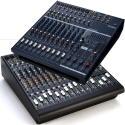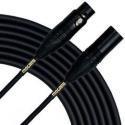Church Sound Systems - 15 Years of Hands-On Experience
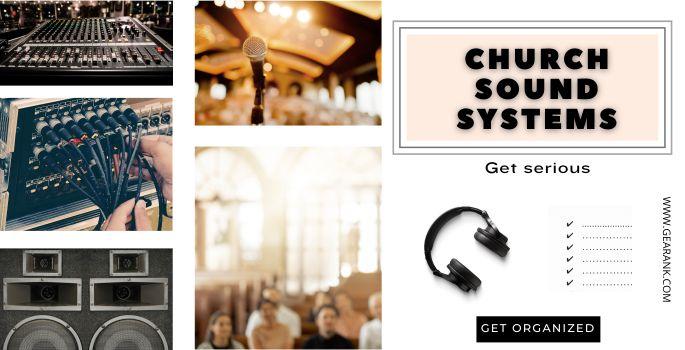
The unique shapes of churches were initially designed to shape sound. A strong voice could be carried across open spaces without church sound systems.
But as churches grew, that strong spoken word was no longer enough. People at the back can no longer hear the message.
To help speeches carry further, some larger churches were made with an echo chamber in the center ceiling. But this resulted in a new problem, excessive echo.
But that's all in the past; now, we have the technology for total sound coverage via PA systems.
But not all churches are the same, so there's no one-size-fits-all ideal solution. You need a fine-tuned PA system for your church venue for the best results.
As a music director, I've helped churches of different sizes tackle sound system-related issues.
I'll draw from my years of experience to give insightful suggestions in church sound setup.
Review Your Current Set Up
First thing to do is review your current setup. Learn where your issues lie, your current goals, and your overall sound quality.
General Checks
Consider the Age of your current sound system. Anything older than a decade needs to be replaced. The equipment would have been used much, which means general wear and tear. Any scratchy sound or unbalanced audio may come from old worn-out tech. It doesn't have to be exactly ten years old; any rusty and dilapidated audio equipment has to be replaced. You'd be lucky to have audio equipment last for a decade anyway.
Next, consider your space. Are certain areas still being reached by your current setup? Has the seating area expanded? Did you move to a bigger venue? Are you playing at an outdoor event? Even if your systems aren't old, you will need to upgrade, if not replace, your current setup to expand your reach.
Lastly, how are you playing music? Everyone's worship style is different. Many churches have live music, but the number of musicians and singers can vary. The types of instruments played can also vary.
Knowing all these will help you determine the number of audio inputs you need in a PA mixer. These will also give you a good idea of the number of cables and power outlets you'll need. The type of speaker system to use is also dependent on the information you gathered above.
Current Overall Sound
Now you have a basic idea of what you need. But before moving on, you need to consider the current sound of your worship space.
Make someone speak through your microphone and play music through your PA system. Listen for sound distortion, look at where the wires are connected, and consider when the sound crackles.
Old sound systems are often made with copper wiring. Copper can quickly wear down from moisture, and a church is never completely damp-free. Fixing or replacing the bad wires could fix your problems.
Secondly, if the sound system works until you hit a specific volume, the amplifier or speaker could be the culprit.
Thirdly, if your choir sounds excellent, but your bands are muffled or distorted, your mixing desk and PA speakers may need an upgrade. More inputs and better power handling are needed, if you want to better handle different musical styles. Sound system know how is an importat part of knowing how to start a band.
It would help if you became an observant audience member to understand sound quality better. Take notes on all the audio types that play through your sound system. Write down which types cause issues and what equipment is used.
What Is Your Project Objective?
You should know your project objective from all of this research and observations. What is the goal you need to accomplish?
The most common objectives are:
- Make the sound system reach all areas in the church
- Ensure speeches are clear
- Ensure music is clear regardless of musical genres
- Any/all of the above without ruining church architecture
These are just some examples. Yours might be more specific.
If you are using a sound engineer to update your systems, they will need your objectives and current equipment list. That way, they can understand your needs and give you a realistic budget.
And speaking of budget, this can be the most critical factor. Churches have different resources and allocations, so this has to be considered before making any decision.
After careful evaluation, you can plan for the next component to upgrade. For optimal results, you may have to replace the entire system altogether.
What Is An Effective Church Sound System?
Effective church sound systems should accomplish and be designed around the following:
- Even sound distribution - no matter where you are in the church, everyone should get the same high-quality sound. This is especially important for sound technicians. They need to hear the sound as the audience hears them, so that they can make correct adjustments.
- Balanced volume - As a long-time music director who has helped different churches, this is one of the most common complaints I find in churches. People find the sound too loud. This should be an "easy fix," but loudness can be subjective without proper measurements. This is why I always recommend equipping techs and musicians with volume meters. This way, they can keep track of how loud the volume is and adjust appropriately. Many churches have switched to in-ear monitors to lower stage volume, reducing loudness.
- Enough Inputs - Small mixers can work well for small churches. But as your instrumentation expands, you'll need more inputs for them to plug into. This will require an upgrade to bigger mixers.
- No feedback - A good stage and PA setup can remove feedback and static noise altogether. Good maintenance practice is also important in keeping unwanted racket at bay.
- Clear sound - if the audio is loud but muffled, it must still be better.
- Doesn't create a distraction - A good sound system should go visually unnoticed.
By the end of your upgrade, your church sound systems should tick every one of these statements. The best sound system is one that fits all your church needs ideally.
General Equipment You'll Need
As a minimum, your church sound systems will need the following equipment:
- Mixer
- Speaker
- Microphones
- Monitors
- XLR Cables
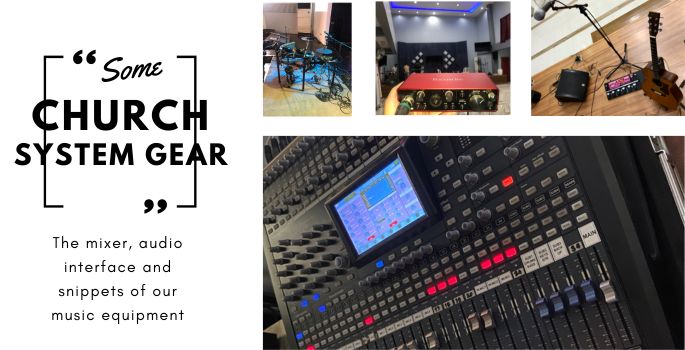
Mixer
A mixer is the main console to which all your instruments and mics connect. It's used to balance and process the sound. It is also the primary volume control for the main speakers and the stage monitors.
Consider how many inputs you need to get a suitable sound board for your churches. If the church is small, you may only need enough for a couple of microphones and amplifiers. A 24-channel mixer should be enough for most small to medium size churches. However, A large church may play host to gigs and needs enough mic inputs for a choir and a full band with drum mics.
Speakers
Over the past few years, I've seen most churches switch from passive to powered speakers as sound reinforcement. And rightly so, given the advantages they provide.
Powered speakers need less space, as the amp and all its processing technology are embedded in the speaker cabinet. And they are easier to implement since you don't have to worry about having a separate amplifier that can power all your speakers.
You have to get accurate measurements of your worship space to get the right type and number of speakers for your venue. With this information, you can get straightforward suggestions on speaker setup. This includes power, size, and quantity. I highly recommend having an experienced tech do an ocular inspection of the venue. There, they can provide more accurate recommendations, especially when you're planning on getting additional speakers.
Having two main speakers is enough for most small to medium size venues. Speaker requirements will get more complex depending on how big your venue is.
Speaker position is an essential key to getting good coverage and sound. High-ceiling venues can benefit from ceiling speakers. Speaker placement is a big topic, but it can be made simple. The Speaker cones should be facing the areas that you want to cover. A sound engineer can give you more accurate position suggestions for your space.
Some churches use small floor speakers placed underneath the pews. These can help distribute the music and sermons without detracting from the interior designs.
Microphones
At least one person during the sermon will need a microphone amplification. If you need to mic the worship team, pianos, drums, and other instruments, ensure that you have enough for these too. Choir microphones should also be considered.
Mics are used throughout a church service, so getting quality mics is of utmost importance. Good quality mics should also be paired with quality cables too. Skimping on mic quality will result in bad sound, dropouts, and other unwanted distractions.
I also recommend using <a href="/guides/wireless-microphone-system">wireless microphone systems</a> because they are easier to set up and reduce cable clutter. The pastor and singers will also appreciate the freedom to move as they speak and sing.
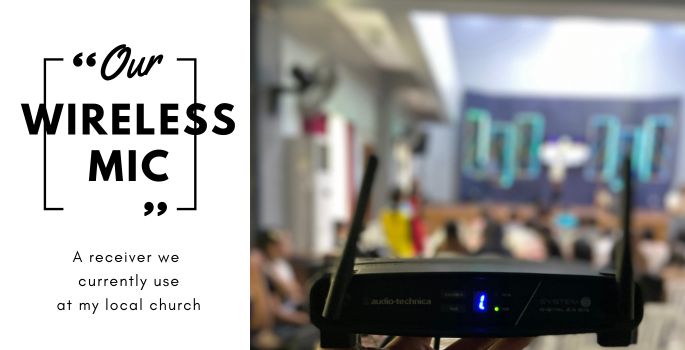
Monitors
Stage monitors are a type of speaker aimed toward the musicians and people on stage. They can significantly improve sound quality as singers and musicians hear themselves better. This is particularly useful in medium to large churches.
XLR Cables and Instrument Cables
Most of your equipment is connected via XLR cables or instrument cables. So it pays to get good quality ones and have them properly maintained.
Bad cables are a common problem in church sound systems. This is why I always recommend getting good quality ones. Or better yet, have a trusted technician custom-build them for you.
You should allocate resources for proper cable maintenance to keep your church sound free of problems.
If you want to worry less about cable, consider switching to wireless systems. Gone are the days when they are deemed unreliable. Wireless mics now provide good sound and stable connections. Wireless transmitters are also easier to use, many have one button auto channel selection. They are widely used in many churches today. The lack of wires also means less visual disruption on your stage and in your building.
Recommended Church Setups
I've said it numerous times, but I'll repeat it. Each church will require a different sound system for its worship service.
But to give you a better idea, here are some general recommendations based on standard church sizes.
Sound System Set Up For Small Churches
A small church can host around 50 people. A church this small will still need a PA system or a mixer, but it doesn't need to be complex.
You can easily pick an "all-in-one" small system that can handle sound quality, volume, and a small handful of inputs. You'll need a couple of microphones based on your worship style, along with two speakers, or maybe four, to cover the space in an even balance.
In this size, regular amps should be enough to get guitarists and bassists heard. In comparison, the keyboardist can go straight to the mixer. Acoustic drums can be too loud for small venues, so electronic drums are the better choice. They are easier to tame so as not to overpower the entire band.
Sound System Set Up For Large Churches
Large churches can easily contain hundreds, if not thousands, of people.
Buildings this large need an installed system of cables that seamlessly run through the structure without causing trip hazards or ruining the architecture.
More attendees usually mean more musicians. This means you need a bigger digital mixer that can handle bands, if not orchestral types of music.
It would also be beneficial to remotely monitor and control the mixer so you can move around the venue to check the audio quality and make quick adjustments while on the move.
Sound dampeners and bass traps may also be needed depending on the structure. Especially for more traditional cathedral churches. Although traditional singing vocals might be heard throughout the structure, traditional churches cannot house a full band without creating feedback.
Because of the complex nature of a large church, you will have specific needs requiring a sound engineer's help. Speaker systems will be combinations of different types, including array and delay speakers.
The budget for a low-ceiling large church will be lower than a high-ceiling alternative. A low ceiling means a reduced echo chamber and a more efficient sound-based radius to manage. Keep this in mind if you happen to be building a new church or redesigning your church structure.
Sound System Set Up For Mid-Sized Churches
Mid-sized churches are anything in between these concepts. You will have a unique existing system, which can only be easily summarized with a sound engineer examining your room size.
You will likely need multiple microphones, a typical band setup, and a mid-range mixer to accommodate them all. To cover all the space, you may also need numerous speakers, including delayed speaker setups for reaching the audience seated at the far back.
Wireless microphones are advisable, paired with a digital mixer.
Online Church Streaming
Because of the pandemic, many churches have started to stream their services online. And this has become a common practice. If this is a new project for your church, then you'll need a PA system compatible with audio streaming. You need a digital mixer with a USB direct output. Or a USB audio interface specifically for your mixer.
Outdoor Worship
You will need an entirely different sound system for outdoor live events.
First, you need to ensure your speakers are lightweight and portable. Even if your church owns the land, you must be able to stow away the equipment in the event of foul weather.
For a large audience, you will need large speakers. You can get portable ones with caster wheels or have them custom attached.
You will also need long-lasting batteries to power your outdoor system. Or a long power extension cable, so you can still plug into the grid.
Make sure you have long XLR cables for better speaker positioning. Place your speakers at the front and your microphones behind them. This will help prevent feedback.
Lastly, make sure you keep everything off the ground. This will help the sound travel to your audience's ears and prevent it from being absorbed or muffled by the earth. This means getting good portable speaker stands.
Common Church Sound System Mistakes
Here are some of the most common mistakes in church PA systems.
Underestimating The Budget
Understanding the budget can be complex. First, you need to hire a sound engineer. Next, consider what equipment you can still use and what you need to sell or recycle. From there, you need to ponder the aesthetics around you and the skill level of your sound team.
Bring this information to your sound engineer, who can offer a cost effective solution. Ask for the maximum and minimum price range to avoid a half-completed task.
Failing To Reach All Locations
As part of your research stage, you must consider the sound quality from all areas. If you only focus on the prominent or most popular spots in your church, you will have poor sound coverage.
Loud Stage Volume
Churches that play contemporary Christian music are prone to this problem. Musicians want to be as loud as possible without regard to stage volume. This is where good monitors and positioning can help. The ideal setup is for each musician to have a monitor. But space and budget limitations will only sometimes allow for this.
In some cases, the bass and drummer can share a monitor since they both need to hear each other. But guitarists and keyboardists will still need their monitor mixes. Backup singers can also share a monitor, but it would be best practice to have a dedicated monitor for the lead vocals.
A good but more expensive alternative is using in-ear monitors. This way, each musician and singer can have their monitors - and do so without adding to the stage volume.
The Location Of Your Booth
The best place for your sound booth would be in the middle of the church. However, there are more aesthetic or practical places to put it.
If you have an older mixer, avoid putting the booth in the back corner, balcony, or outside the main hall. Ideally, the sound operator should be near the main congregation to hear the same sounds as the crowd.
The position of the sound booth would matter less if you own modern mixers that can be controlled remotely. The tech can move around the venue and make adjustments without being physically near the mixing board. Most modern digital mixers offer this feature. Their partner apps let you make mixer adjustments on your tablets and phones.
Final Thoughts
By now, you should better understand your church's sound system, the issues surrounding it, and your needs. It should also be clear that you need a trusted sound engineer who can recommend a setup suited to your needs.
My last piece of advice is to get trained in this area. There are fast-track courses available that can help you understand all elements of your church sound system. Since sound is a big part of church services, it is essential to know more about it, regardless of your position at church.





